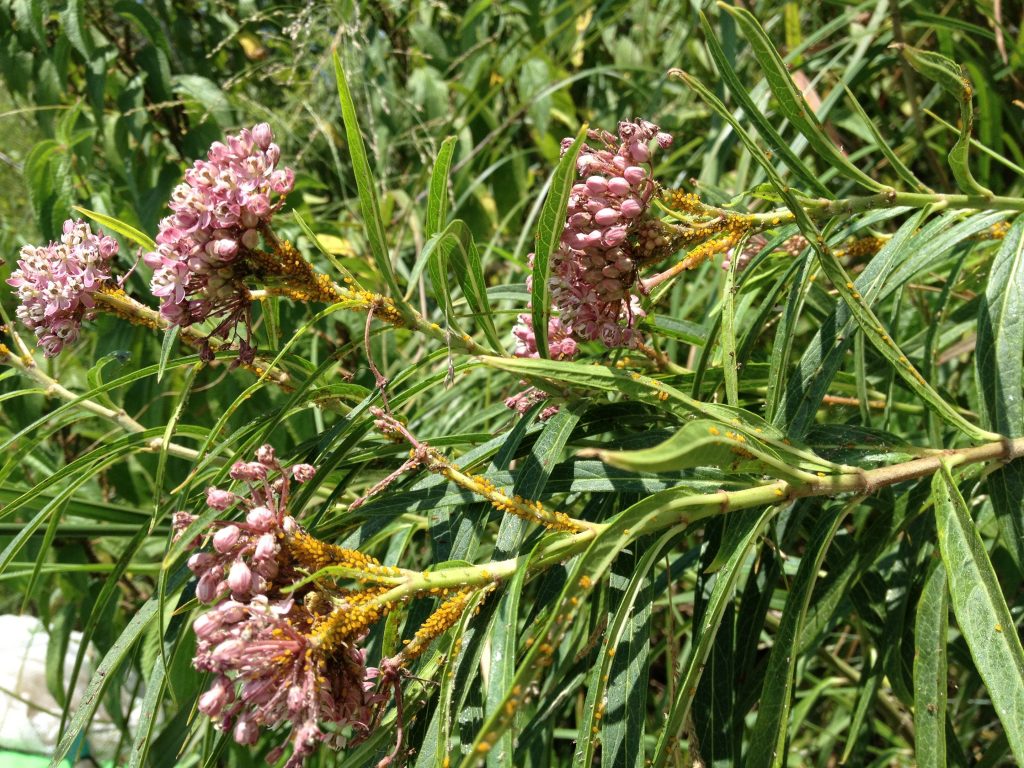Color Spot Nursery, one of the top national wholesale growers in the country, said this week they will explore heeding the call for clean, chemical-free, preferably native milkweed plants. The company said they are considering growing select Asclepias species, the only plant on which Monarch butterflies will lay their eggs, WITHOUT any systemic pesticides. Thanks to Craig the Butterflyman for the tip.
The California-based mega grower, which has seven nursery locations in Texas including one in San Antonio, said they were responding to their customers, which include Lowes, Home Depot, Wal-Mart and hundreds of independent nurseries across the country. Color Spot does not sell directly to the public.
“Our customers got in trouble with the community,” said Kevin Grossberndt, Commercial Sales Manager for the Southwest Division of Color Spot. “We all learned a lesson.”
Gorssberndt said Color Spot is well aware of Monarch butterfly enthusiasts’ dismay at buying milkweeds to feed hungry Monarch caterpillars, and being misinformed by retail nursery staff that milkweed plants had not been sprayed with systemic pesticides.
After customers purchased milkweed plants from local nurseries and later placed their caterpillars on them to feed on the milkweed leaves, the caterpillars perished within hours. That’s because large growers like Color Spot often spray the plants with systemic pesticides early in the year and the poisons used can linger for many months. The phenomenon has been well documented on these webpages. We call it Desperately Seeking Milkweed syndrome.

Kevin Grossberndt stands in a quanset hut of Tropical milkweed and Butterfly weed at Colorspot Nursery in western San Antonio. The company is exploring cultivation of chemical free milkweeds. –PHoto by Monika Maeckle
Bernhardt, trained as a horticulturist, said Color Spot is considering which species to plant and is likely to go with Tropical milkweed, Asclepias curassavica, and Butterfly weed, Aslcepias tuberosa.
The Texas Butterfly Ranch and our hydroponic milkweed growing partner Local Sprout made a pitch to Bernhardt to consider cultivating Swamp milkweed, Asclepias incarnata, since it is relatively easy-to-grow, a great nectar and host plant and prolific pink bloomer native to the area. Most native Texas milkweed species are famously persnickety to grow. Swamp milkweed is not. Check out the Texas Butterfly Ranch milkweed guide for more info.
Dr. Chip Taylor, the founder of Monarch Watch, chimed in via email, suggesting that Color Spot might try Green Antelope Horn milkweed, Asclepias viridis. “Viridis is probably the second most important plant on the Monarch’s menu,” Dr. Taylor said. “It’s the main host for first generation Monarchs. It’s also the most abundant of the Texas milkweeds and survives in pastures quite well.”
Which is absolutely true, but it’s famously challenging to grow from pots and transplants.
“Texas is too dry and hot for syriaca,” Taylor added.
During a tour of Color Spot’s 400-acre growing facility in western San Antonio near Lackland Airforce base, Grossberndt described the special challenges commercial growers will face in growing chemical-free milkweed.
As we all know, milkweed is an aphid magnet, and many people will not buy plants with aphids on them. Traditionally, Color Spot deals with aphids and other pests via pesticides in order to deliver pristine plants to retail outlets.
With labor one of their highest costs, hand removal of aphids may not be practical. Color Spot already uses robots to move plants around. The R2D2-like machines rearranged a plot of potted rose bushes as we all watched in amazement. But since its doubtful that an aphid-squishing robot will be developed anytime soon, Color Spot will have to be resourceful.
“We might be able to do it with a soap knock-down or possibly explore using beneficials like ladybugs or parasitoid wasps,” said Grossberndt. “We’ll have to see.”
Video by Mitchell Hagney
Dr. Taylor also recommended beneficial insects. “We are happy to recommend various biological control agents. They seem pricey until you see how effective they are but the grower has to have personnel that is alert to the build-up of pests so that the biologicals can be deployed effectively,” he said. Grossberndt agreed that training of personnel, especially Color Spot’s technology services team, would have to be part of the plan.
Since the nursery typically sprays ornamental and other inventory with systemic pesticides, the growhouse would also need to be strategically placed out of any possible wind drift and would require polyurethane sides, versus less expensive shade cloth or plastic to assure no chemicals entered the clean zone.

To be sprayed or not to be sprayed? Milkweed plants at Color Spot Nursery. Kevin Gorssberndt is hoping the nursery can figure out a way to produce lots of milkweed without chemicals. Photo by Mitchell Hagney
Grossberndt showed us one quanset hut filled with a mix of Tropical milkweed and Butterfly weed–some newly sprouted from seed this year, others cut back and sprouting new growth from last season. Aphids adorned the underside of the older plants, suggesting the plants had not been sprayed with pesticides.
Yet.
Will they be? “I’m hoping they won’t,” said Bernhardt. “These plants were in the middle of other plants, so we’ll just have to see how it goes,” said Bernhardt. “I’m making the case.”
Grossberndt suggested that Color Spot might have some clean plants on the market by late summer or early fall–hopefully in time for the fall migration when those of us who raise Monarchs often run out of milkweed for those butterflies that break their diapause and reproduce here. ” I can’t really guarantee a timeline,” said Grossberndt.
P.S. Have you taken our What Kind of Milkweed Survey? Help us convince Color Spot and other commercial growers to offer clean, chemical free milkweed by voting for the species you’d like to see in local nurseries. Here’s the link and feel free to share the survey. GRACIAS!
Related posts:
- Q&A with Dr. Lincoln Brower
- Survey: Monarch Butterfly Enthusiasts will Pay More for Clean, Native Milkweeds
- Monarch Tagged With Lincoln Brower on Llano River Recovered at El Rosario
- MIlkweed Guide for Central and South Texas
- Assessing Drought, Chasing Monarchs on the Llano with Dr. Lincoln Brower
- Monarch Butterfly News Spurs EXTREME Interest in Native Milkweeds
- Endangered Species Act Wrong Tool for the Job of Monarch Butterfly Conservation?
- Monarch Butterfly Inches Toward “Threatened” Status Under Endangered Species Act
- How to Get Native Milkweed Seeds to Germinate
- Monsanto: Absolutely committed to Monarch Butterfly Conservation
- Native American Seed and the Challenges of Persnickety Texas Native Milkweeds
- How to Raise Monarch Butterflies at Home, Part One
Like what you’re reading? Follow butterfly and native plant news at the Texas Butterfly Ranch. Sign up for email delivery, like us on Facebook, or follow us on Twitter, @monikam.



where is the best place to purchase milkweed in the San Antonio area?
As best I can tell, there’s none available right now. However Rainbow Gardens, Millberger’s, Fanick’s all carry it later in the season. Just make sure you ask them if it’s been sprayed. MM
I think one of my tropical milkweed plants was sprayed with an insecticide as I found some dead caterpillars near it. The plant has a lot of seed pods on it right now. My question is- are the seeds safe to grow new plants in the springtime?
Thanks for any advice.
Helen
This is great news and right here in Texas! I am going to write them and encourage them to make this change! I am passing this on through all my media sources!
i will be happy when i am told i can finally buy milkweed so i can plant some on our acre xx
20 years ago a huge number of fall migratory monarchs developed on syriaca milkweeds that grew WITHIN upper midwestern crop fields. Those milkweeds are gone now, but a large number still grow in the hundreds of thousands of miles worth of gravel farm road ditches that border the GMO crops like this: http://www.imagegainer.com/images/PaulCherubini/plummer.jpg Those ditch milkweeds are in slow decline too, but the decline is not being pubicized because there is no organized effort to monitor and write articles about what’s happening to them. Instead, the monarch conservation community is focused on selling and planting new milkweeds in urban/suburban settings instead of saving or expanding the volume of existing milkweed that still grows in rural farm road ditches. So I think the size of the fall migratory population can be expected to continue to incrementally decline in the years ahead due to lack on interest in monitoring and publicizing what happening to the rural farm road ditch milkweeds.
I agree with Paul Cherubini. The road side milkweed absolutely needs protection from being mowed. States and counties must agree not to mow until past Monarch migration. And offer whatever additional protection is needed. Give an incentive to land owners to leave native milkweed. Horses and cattle seldom try to eat milkweed unless they are desparate for food.
Asclepias incarnata since it is native and the easiest of the natives to grow. (according to my research). Does not require constant moisture as some folks believe. Plant in well composted soil , add mulch and, water well until established. Supplemental watering as needed.
Have you ever attempted to work with Howard Garrett who has a weekly national radio talk show on organic gardening? He is located in Dallas. He is more organic than any other that I have read or heard. His website is dirtdoctor.com. I wonder if he is oblivious of all you are trying to do.
I would love to see you grow asclepias asperula, but any clean milkweed is better than milkweed with pesticides!
The San Antonio Botanical Gardens sells pesticide free milkweed at its plant sales, but it has a very limited supply; you have to be at the sale early. Next sale is during Spring Break.
New article with an opinion about Asclepias tuberosa http://www.crozetgazette.com/2015/03/blue-ridge-naturalist-butterfly-weed-wont-save-monarchs/
Don’t bother growing milkweed if it isn’t chemical free. High pressure rinsing of milkweed during growth and prior to shipping will help rid the plants of the aphid pests. Being soft bodied insects they are often killed by the blasts. I often do that with my homegrown milkweed and the plants are not damaged by water unless the pressure is too intense. I would think the robots could be programmed to do the work. Another option is insecticidal soap which is not systemic.